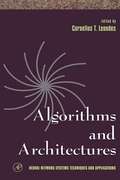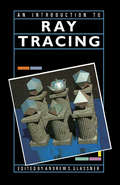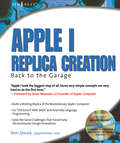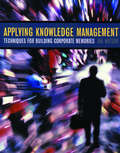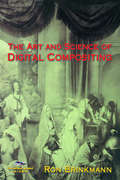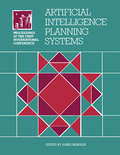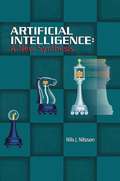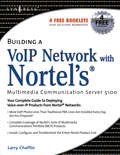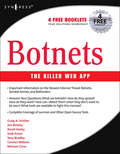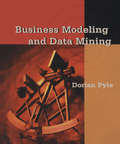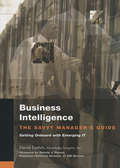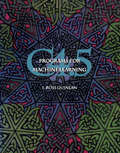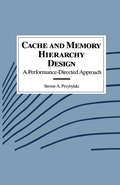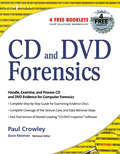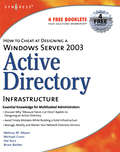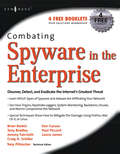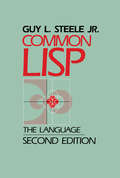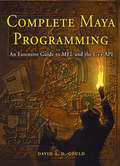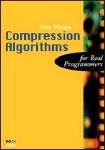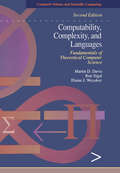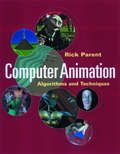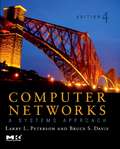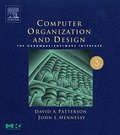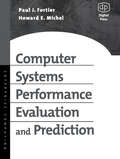- Table View
- List View
Algorithms and Architectures (ISSN #Volume 1)
by Cornelius T. LeondesThis volume is the first diverse and comprehensive treatment of algorithms and architectures for the realization of neural network systems. It presents techniques and diverse methods in numerous areas of this broad subject. The book covers major neural network systems structures for achieving effective systems, and illustrates them with examples. This volume includes Radial Basis Function networks, the Expand-and-Truncate Learning algorithm for the synthesis of Three-Layer Threshold Networks, weight initialization, fast and efficient variants of Hamming and Hopfield neural networks, discrete time synchronous multilevel neural systems with reduced VLSI demands, probabilistic design techniques, time-based techniques, techniques for reducing physical realization requirements, and applications to finite constraint problems. A unique and comprehensive reference for a broad array of algorithms and architectures, this book will be of use to practitioners, researchers, and students in industrial, manufacturing, electrical, and mechanical engineering, as well as in computer science and engineering.Radial Basis Function networksThe Expand-and-Truncate Learning algorithm for the synthesis of Three-Layer Threshold NetworksWeight initializationFast and efficient variants of Hamming and Hopfield neural networksDiscrete time synchronous multilevel neural systems with reduced VLSI demandsProbabilistic design techniquesTime-based techniquesTechniques for reducing physical realization requirementsApplications to finite constraint problemsPractical realization methods for Hebbian type associative memory systemsParallel self-organizing hierarchical neural network systemsDynamics of networks of biological neurons for utilization in computational neuroscience
An Introduction to Ray Tracing (The Morgan Kaufmann Series in Computer Graphics)
by Andrew S. GlassnerThe creation of ever more realistic 3-D images is central to the development of computer graphics. The ray tracing technique has become one of the most popular and powerful means by which photo-realistic images can now be created. The simplicity, elegance and ease of implementation makes ray tracing an essential part of understanding and exploiting state-of-the-art computer graphics.An Introduction to Ray Tracing develops from fundamental principles to advanced applications, providing "how-to" procedures as well as a detailed understanding of the scientific foundations of ray tracing. It is also richly illustrated with four-color and black-and-white plates. This is a book which will be welcomed by all concerned with modern computer graphics, image processing, and computer-aided design.Provides practical "how-to" informationContains high quality color plates of images created using ray tracing techniquesProgresses from a basic understanding to the advanced science and application of ray tracing
Apple I Replica Creation: Back to the Garage
by Tom OwadThe perfect book for computer hobbyists, Apple I Replica Creation: Back to the Garage is sure to equally appeal both to kids with gift certificates looking for fun on a snowy January day as well as to adults eager to learn the basics of simple microcomputer design. The book will begin by teaching readers the basics of computer processing by discussing the functionality of the 9 chip on the Apple I motherboard. From there, readers will be taught the basics of memory access and video input and output. Readers then learn how to assemble the various hardware components into a fully functioning Apple I replica. Finally, readers will learn how to write their own applications to take run on their new/old computer.*Written by the webmaster of AppleFritter.com, which is the most popular Mac hobbyist Web site on the internet with over 10,000 visitors a day. *Interest in vintage Apple I Computers is extremely high, with original machines selling for as much as $50,000. *The only modern-day book to address general microcomputer design from a hobbyist perspective
Applying Knowledge Management: Techniques for Building Corporate Memories (The Morgan Kaufmann Series in Artificial Intelligence)
by Ian WatsonThe wholesale capture and distribution of knowledge over the last thirty years has created an unprecedented need for organizations to manage their knowledge assets. Knowledge Management (KM) addresses this need by helping an organization to leverage its information resources and knowledge assets by "remembering" and applying its experience. KM involves the acquisition, storage, retrieval, application, generation, and review of the knowledge assets of an organization in a controlled way. Today, organizations are applying KM throughout their systems, from information management to marketing to human resources. Applying Knowledge Management: Techniques for Building Corporate Memories examines why case-based reasoning (CBR) is so well suited for KM. CBR can be used to adapt solutions originally designed to solve problems in the past, to address new problems faced by the organization. This book clearly demonstrates how CBR can be successfully applied to KM problems by presenting several in-depth case-studies. Ian Watson, a well-known researcher in case-based reasoning and author of the introductory book, Applying CBR: Techniques for Enterprise Systems has written this book specifically for IT managers and knowledge management system developers.* Provides 7 real-world applications of knowledge management systems that use case-based reasoning techniques.* Presents the technical information needed to implement a knowledge management system.* Offers insights into the development of commercial KM CBR applications* Includes information on CBR software vendors, CBR consultants and value added resellers
The Art and Science of Digital Compositing (The Morgan Kaufmann Series in Computer Graphics)
by Ron BrinkmannComputer-generated visual effects are now used extensively in feature films, commercials, music videos, and multimedia. The backbone of this process, the final and most important step, is known as digital compositing. The Art and Science of Digital Compositing is a comprehensive reference that provides a complete overview of the technical and the artistic nature of this process. This book covers a wide range of topics from basic image creation, representation, and manipulation, to a look at the visual cues that are necessary to create a believable composite. Designed as both an introduction to the field as well as a valuable technical reference, this book should be of interest to both novices and professionals alike. Written by a working professional in the visual effects industry, the book provides over 250 different images and illustrations (including a 40-page color insert) as well as a complete glossary of compositing and visual-effects terminology. Also included are in-depth case studies from well-known films such as Speed, Independence Day, and Titanic.Balances fundamental "hard science" topics with the more qualitative/artistic challenges which face anyone involved in a digital composition projectProvides examples and illustrations from motion picture workCD-ROM contains additional composition examples, illustrations, and development softwareIncludes 32 pages of colour
Artificial Intelligence Planning Systems: Proceedings of the First Conference (AIPS 92)
by James HendlerArtificial Intelligence Planning Systems documents the proceedings of the First International Conference on AI Planning Systems held in College Park, Maryland on June 15-17, 1992.This book discusses the abstract probabilistic modeling of action; building symbolic primitives with continuous control routines; and systematic adaptation for case-based planning. The analysis of ABSTRIPS; conditional nonlinear planning; and building plans to monitor and exploit open-loop and closed-loop dynamics are also elaborated. This text likewise covers the modular utility representation for decision-theoretic planning; reaction and reflection in tetris; and planning in intelligent sensor fusion. Other topics include the resource-bounded adaptive agent, critical look at Knoblock's hierarchy mechanism, and traffic laws for mobile robots. This publication is beneficial to students and researchers conducting work on AI planning systems.
Artificial Intelligence: A New Synthesis (The Morgan Kaufmann Series in Artificial Intelligence)
by Nils J. NilssonIntelligent agents are employed as the central characters in this new introductory text. Beginning with elementary reactive agents, Nilsson gradually increases their cognitive horsepower to illustrate the most important and lasting ideas in AI. Neural networks, genetic programming, computer vision, heuristic search, knowledge representation and reasoning, Bayes networks, planning, and language understanding are each revealed through the growing capabilities of these agents. The book provides a refreshing and motivating new synthesis of the field by one of AI's master expositors and leading researchers. Artificial Intelligence: A New Synthesis takes the reader on a complete tour of this intriguing new world of AI.An evolutionary approach provides a unifying theme Thorough coverage of important AI ideas, old and newFrequent use of examples and illustrative diagramsExtensive coverage of machine learning methods throughout the textCitations to over 500 referencesComprehensive index
Building a VoIP Network with Nortel's Multimedia Communication Server 5100
by Larry ChaffinThe first book published on deploying Voice Over IP (VoIP) products from Nortel Networks, the largest supplier of voice products in the world.This book begins with a discussion of the current protocols used for transmitting converged data over IP as well as an overview of Nortel’s hardware and software solutions for converged networks. In this section, readers will learn how H.323 allows dissimilar communication devices to communicate with each other, and how SIP (Session Initiation Protocol) is used to establish, modify, and terminate multimedia sessions including VOIP telephone calls. This section next introduces the reader to the Multimedia Concentration Server 5100, and Nortel’s entire suite of Multimedia Communications Portfolio (MCP) products. The remaining chapters of the book teach the reader how to design, install, configure, and troubleshoot the entire Nortel product line.· If you are tasked with designing, installing, configuring, and troubleshooting a converged network built with Nortel's Multimedia Concentration Server 5100, and Multimedia Communications Portfolio (MCP) products, then this is the only book you need. · It shows how you'll be able to design, build, secure, and maintaining a cutting-edge converged network to satisfy all of your business requirements· Also covers how to secure your entire multimedia network from malicious attacks
Blondie24: Playing at the Edge of AI (The Morgan Kaufmann Series in Artificial Intelligence)
by David B. FogelBlondie24 tells the story of a computer that taught itself to play checkers far better than its creators ever could by using a program that emulated the basic principles of Darwinian evolution--random variation and natural selection-- to discover on its own how to excel at the game. Unlike Deep Blue, the celebrated chess machine that beat Garry Kasparov, the former world champion chess player, this evolutionary program didn't have access to strategies employed by human grand masters, or to databases of moves for the endgame moves, or to other human expertise about the game of chekers. With only the most rudimentary information programmed into its "brain," Blondie24 (the program's Internet username) created its own means of evaluating the complex, changing patterns of pieces that make up a checkers game by evolving artificial neural networks---mathematical models that loosely describe how a brain works. It's fitting that Blondie24 should appear in 2001, the year when we remember Arthur C. Clarke's prediction that one day we would succeed in creating a thinking machine. In this compelling narrative, David Fogel, author and co-creator of Blondie24, describes in convincing detail how evolutionary computation may help to bring us closer to Clarke's vision of HAL. Along the way, he gives readers an inside look into the fascinating history of AI and poses provocative questions about its future.Brings one of the most exciting areas of AI research to life by following the story of Blondie24's development in the lab through her evolution into an expert-rated checkers player, based on her impressive success in Internet competition.Explains the foundations of evolutionary computation, simply and clearly.Presents complex material in an engaging style for readers with no background in computer science or artificial intelligence.Examines foundational issues surrounding the creation of a thinking machine.Debates whether the famous Turing Test really tests for intelligence.Challenges deeply entrenched myths about the successes and implication of some well-known AI experiments.Shows Blondie's moves with checkerboard diagrams that readers can easily follow.
Botnets: The Killer Web Applications
by Craig Schiller James R. BinkleyThe book begins with real world cases of botnet attacks to underscore the need for action. Next the book will explain botnet fundamentals using real world examples. These chapters will cover what they are, how they operate, and the environment and technology that makes them possible. The following chapters will analyze botnets for opportunities to detect, track, and remove them. Then the book will describe intelligence gathering efforts and results obtained to date. Public domain tools like OurMon, developed by Jim Binkley of Portland State University, will be described in detail along with discussions of other tools and resources that are useful in the fight against Botnets.This is the first book to explain the newest internet threat - Botnets, zombie armies, bot herders, what is being done, and what you can do to protect your enterpriseBotnets are the most complicated and difficult threat the hacker world has unleashed - read how to protect yourself
Business Modeling and Data Mining (The Morgan Kaufmann Series in Data Management Systems)
by Dorian PyleBusiness Modeling and Data Mining demonstrates how real world business problems can be formulated so that data mining can answer them. The concepts and techniques presented in this book are the essential building blocks in understanding what models are and how they can be used practically to reveal hidden assumptions and needs, determine problems, discover data, determine costs, and explore the whole domain of the problem. This book articulately explains how to understand both the strategic and tactical aspects of any business problem, identify where the key leverage points are and determine where quantitative techniques of analysis -- such as data mining -- can yield most benefit. It addresses techniques for discovering how to turn colloquial expression and vague descriptions of a business problem first into qualitative models and then into well-defined quantitative models (using data mining) that can then be used to find a solution. The book completes the process by illustrating how these findings from data mining can be turned into strategic or tactical implementations.· Teaches how to discover, construct and refine models that are useful in business situations· Teaches how to design, discover and develop the data necessary for mining · Provides a practical approach to mining data for all business situations· Provides a comprehensive, easy-to-use, fully interactive methodology for building models and mining data· Provides pointers to supplemental online resources, including a downloadable version of the methodology and software tools.
Business Intelligence: The Savvy Manager's Guide (The Morgan Kaufmann Series on Business Intelligence)
by David LoshinBusiness Intelligence describes the basic architectural components of a business intelligence environment, ranging from traditional topics such as business process modeling, data modeling, and more modern topics such as business rule systems, data profiling, information compliance and data quality, data warehousing, and data mining. This book progresses through a logical sequence, starting with data model infrastructure, then data preparation, followed by data analysis, integration, knowledge discovery, and finally the actual use of discovered knowledge. The book contains a quick reference guide for business intelligence terminology. Business Intelligence is part of Morgan Kaufmann's Savvy Manager's Guide series.* Provides clear explanations without technical jargon, followed by in-depth descriptions.* Articulates the business value of new technology, while providing relevant introductory technical background.* Contains a handy quick-reference to technologies and terminologies.* Guides managers through developing, administering, or simply understanding business intelligence technology.* Bridges the business-technical gap.* Is Web enhanced. Companion sites to the book and series provide value-added information, links, discussions, and more.
C4.5: Programs for Machine Learning
by J. Ross QuinlanClassifier systems play a major role in machine learning and knowledge-based systems, and Ross Quinlan's work on ID3 and C4.5 is widely acknowledged to have made some of the most significant contributions to their development. This book is a complete guide to the C4.5 system as implemented in C for the UNIX environment. It contains a comprehensive guide to the system's use , the source code (about 8,800 lines), and implementation notes. C4.5 starts with large sets of cases belonging to known classes. The cases, described by any mixture of nominal and numeric properties, are scrutinized for patterns that allow the classes to be reliably discriminated. These patterns are then expressed as models, in the form of decision trees or sets of if-then rules, that can be used to classify new cases, with emphasis on making the models understandable as well as accurate. The system has been applied successfully to tasks involving tens of thousands of cases described by hundreds of properties. The book starts from simple core learning methods and shows how they can be elaborated and extended to deal with typical problems such as missing data and over hitting. Advantages and disadvantages of the C4.5 approach are discussed and illustrated with several case studies. This book should be of interest to developers of classification-based intelligent systems and to students in machine learning and expert systems courses.
Cache and Memory Hierarchy Design: A Performance Directed Approach (ISSN)
by Steven A. PrzybylskiAn authoritative book for hardware and software designers. Caches are by far the simplest and most effective mechanism for improving computer performance. This innovative book exposes the characteristics of performance-optimal single and multi-level cache hierarchies by approaching the cache design process through the novel perspective of minimizing execution times. It presents useful data on the relative performance of a wide spectrum of machines and offers empirical and analytical evaluations of the underlying phenomena. This book will help computer professionals appreciate the impact of caches and enable designers to maximize performance given particular implementation constraints.
CD and DVD Forensics
by Paul CrowleyCD and DVD Forensics will take the reader through all facets of handling, examining, and processing CD and DVD evidence for computer forensics. At a time where data forensics is becoming a major part of law enforcement and prosecution in the public sector, and corporate and system security in the private sector, the interest in this subject has just begun to blossom.CD and DVD Forensics is a how to book that will give the reader tools to be able to open CDs and DVDs in an effort to identify evidence of a crime. These tools can be applied in both the public and private sectors. Armed with this information, law enforcement, corporate security, and private investigators will be able to be more effective in their evidence related tasks. To accomplish this the book is divided into four basic parts: (a) CD and DVD physics dealing with the history, construction and technology of CD and DVD media, (b) file systems present on CDs and DVDs and how these are different from that which is found on hard disks, floppy disks and other media, (c) considerations for handling CD and DVD evidence to both recover the maximum amount of information present on a disc and to do so without destroying or altering the disc in any way, and (d) using the InfinaDyne product CD/DVD Inspector to examine discs in detail and collect evidence.This is the first book addressing using the CD/DVD Inspector product in a hands-on manner with a complete step-by-step guide for examining evidence discsSee how to open CD's and DVD'd and extract all the crucial evidence they may contain
How to Cheat at Designing a Windows Server 2003 Active Directory Infrastructure (How to Cheat)
by Melissa M. Meyer Michael Cross Hal Kurz Brian BarberWindows 2003 Server is unquestionably the dominant enterprise level operating system in the industry, with 95% of all companies running it. And for the last tow years, over 50% of all product upgrades have been security related. Securing Windows Server, according to bill gates, is the company's #1 priority.The book will start off by teaching readers to create the conceptual design of their Active Directory infrastructure by gathering and analyzing business and technical requirements. Next, readers will create the logical design for an Active Directory infrastructure. Here the book starts to drill deeper and focus on aspects such as group policy design. Finally, readers will learn to create the physical design for an active directory and network Infrastructure including DNS server placement; DC and GC placements and Flexible Single Master Operations (FSMO) role placement. The next book in our best selling and critically acclaimed How to Cheat series. This is the perfect book for users who have already purchased How to Cheat at Managing Windows 2003 Small Business Server.* Active Directory is the market leader in the directory services space, and 57% of all Microsoft corporate customers have deployed AD* Follows Syngress's proven "How To Cheat" methodology* Companion Web site offers dozens of templates, "Cheat Sheets", and checklists for readers
Combating Spyware in the Enterprise: Discover, Detect, and Eradicate the Internet's Greatest Threat
by Paul PiccardCombating Spyware in the Enterprise is the first book published on defending enterprise networks from increasingly sophisticated and malicious spyware.Combating Spyware in the Enterprise begins by examining the various types of insidious spyware and adware currently propagating across the internet and infiltrating enterprise networks. This section closely examines Spyware’s ongoing transformation from nuisance to malicious, sophisticated attack vector. Next, the book uncovers spyware’s intricate economy and network of malicious hackers and criminals. Forensic investigations presented in this section of the book reveal how increasingly sophisticated spyware can compromise enterprise networks via trojans, keystroke loggers, system monitoring, distributed denial of service attacks, backdoors, viruses, and worms. After close examination of these attack vectors, the book begins to detail both manual and automated techniques for scanning your network for the presence of spyware, and customizing your IDS and IPS to detect spyware. From here, the book goes on to detail how to prevent spyware from being initially installed to mitigating the damage inflicted by spyware should your network become infected. Techniques discussed in this section include slowing the exposure rate; web filtering; using FireFox, MacOSX, or Linux; patching and updating, machine restrictions, shielding, deploying anti-spyware, and re-imaging. The book concludes with an analysis of the future of spyware and what the security community must accomplish to win the ware against spyware.* A recent survey published by Information Security Magazine stated that "combating spyare" was the #2 priority for security professionals in 2005* Despite the high priority placed on combating spyware by security professionals, there are no other books published or announced that address this market * Author Paul Piccard is Director of Research for Webroot, which is a market leader for pure-play anti-spyware vendors
Common LISP: The Language (HP Technologies)
by Guy SteeleThe defacto standard - a must-have for all LISP programmers. In this greatly expanded edition of the defacto standard, you'll learn about the nearly 200 changes already made since original publication - and find out about gray areas likely to be revised later. Written by the Vice- Chairman of X3J13 (the ANSIcommittee responsible for the standardization of Common Lisp) and co-developer of the language itself, the new edition contains the entire text of the first edition plus six completely new chapters. They cover: - CLOS, the Common Lisp Object System, with new features to support function overloading and object-oriented programming, plus complete technical specifications * Loops, a powerful control structure for multiple variables * Conditions, a generalization of the error signaling mechanism * Series and generators * Plus other subjects not part of the ANSI standards but of interest to professional programmers. Throughout, you'll find fresh examples, additional clarifications, warnings, and tips - all presented with the author's customary vigor and wit.
Complete Maya Programming: An Extensive Guide to MEL and C++ API (The Morgan Kaufmann Series in Computer Graphics)
by David GouldLearning Maya, the world's leading 3D animation and effects package, is a challenge, especially for those who want to master Maya's versatile programming features in addition to its built-in tools. Finally, here is a practical, step-by-step guide that shows how to use Maya to its fullest potential, beginning with the basics. Readers of Complete Maya Programming will first gain a thorough understanding of Maya's inner workings, and then learn how to customize and extend Maya with scripts and plugins that take control and productivity to new levels.Users new to programming can apply Maya's easy scripting language MEL (Maya Embedded Language), while more advanced users can work with the C++ API (Application Progamming Interface). Both a fundamental tutorial for Maya beginners and a solid reference for experienced developers, Complete Maya Programming is every user's guide to Maya mastery.* Provides a multitude of real-world examples illustrating applications of Maya programming.* Demonstrates how to use MEL to control Maya, customize its interface, automate procedures, and more* Details how to use the C++ API to modify Maya functionality and develop tools and features to meet any need* Explains when to use MEL, when to use the C++ API, and how to use them together* Ideal for technical directors, developers, or anyone wishing to to master Maya* Provides a storehouse of MEL scripts and C++ source code, glossary, and list of resources, available at www.davidgould.com
Compression Algorithms for Real Programmers (The For Real Programmers Series)
by Peter WaynerIn life, time is money, and on the Internet, the size of data is money. Small programs and small files take less disk space and cost less to send over the Internet. Compression Algorithms for Real Programmers describes the basic algorithms and approaches for compressing information so you can create the smallest files possible. These new algorithms are making it possible for people to take impossibly large audio and video files and compress them enough that they can flow over the Internet.* Examines the classic algorithms like Huffman coding, arithmetic compression, and dictionary-based schemes in depth* Describes the basic approaches used to squeeze audio and video signals by factors of as much as 100:1* Discusses the philosophy of compression to illustrate the underlying trade-offs in the algorithms* Explores the use of wavelets and other modeling techniques that use repetitive functions to squeeze audio and video* Shows how programming solutions like Adobe PostScript can save space and make networks more efficient* Describes new approaches using fractals and grammars just being explored by the compression community* Shows how to extend the algorithms and use them for copyright protection
Computability, Complexity, and Languages: Fundamentals of Theoretical Computer Science (Computer Science and Scientific Computing)
by Martin Davis Ron Sigal Elaine J. WeyukerComputability, Complexity, and Languages is an introductory text that covers the key areas of computer science, including recursive function theory, formal languages, and automata. It assumes a minimal background in formal mathematics. The book is divided into five parts: Computability, Grammars and Automata, Logic, Complexity, and Unsolvability.Computability theory is introduced in a manner that makes maximum use of previous programming experience, including a "universal" program that takes up less than a page.The number of exercises included has more than tripled.Automata theory, computational logic, and complexity theory are presented in a flexible manner, and can be covered in a variety of different arrangements.
Computer Animation: Algorithms and Techniques (The Morgan Kaufmann Series in Computer Graphics)
by Rick ParentWhether you're a programmer developing new animation functionality or an animator trying to get the most out of your current animation software, Computer Animation: Algorithms and Techniques will help work more efficiently and achieve better results. For programmers, this book provides a solid theoretical orientation and extensive practical instruction-information you can put to work in any development or customization project. For animators, it provides crystal-clear guidance on determining which of your concepts can be realized using commercially available products, which demand custom programming, and what development strategies are likely to bring you the greatest success.* Expert instruction from a pace-setting computer graphics researcher.* Provides in-depth coverage of established and emerging animation algorithms.* For readers who lack a strong scientific background, introduces the necessary concepts from mathematics and physics.* Illustrates advanced programming techniques with highly detailed working examples.* Via the companion Web site, provides lecture notes from the author's course for professors, example animations based on the programs covered in the book, Java applets, and links to relevant Web sites.* Special contributions from Dave S. Ebert on Natural Phenomena in Chapter 5* Special contributions from Scott King, Meg Geroch, Doug Roble, and Matt Lewis on Articulated Figures in Chapter 6.
Computer Networks ISE: A Systems Approach (ISSN)
by Larry L. Peterson Bruce S. DavieComputer Networks ISE, Fourth Edition, is the only introductory computer networking book written by authors who have had first-hand experience with many of the protocols discussed in the book, who have actually designed some of them as well, and who are still actively designing the computer networks today. This newly revised edition continues to provide an enduring, practical understanding of networks and their building blocks through rich, example-based instruction. The authors' focus is on the why of network design, not just the specifications comprising today's systems but how key technologies and protocols actually work in the real world to solve specific problems. The new edition makes less use of computer code to explain protocols than earlier editions. Moreover, this new edition shifts the focus somewhat higher in the protocol stack where there is generally more innovative and exciting work going on at the application and session layers than at the link and physical layers.Completely updated with NEW sidebars discussing successes/failures of previously deployed networksThorough companion website with downloadable OpNet network simulation software and lab experiments manualExpanded coverage of topics of utmost importance to today's networking professionals, e.g., security, wireless, multimedia applications
Computer Organization and Design: The Hardware/Software Interface (ISSN)
by David A. Patterson John L. HennessyThis best selling text on computer organization has been thoroughly updated to reflect the newest technologies. Examples highlight the latest processor designs, benchmarking standards, languages and tools. As with previous editions, a MIPs processor is the core used to present the fundamentals of hardware technologies at work in a computer system. The book presents an entire MIPS instruction set—instruction by instruction—the fundamentals of assembly language, computer arithmetic, pipelining, memory hierarchies and I/O. A new aspect of the third edition is the explicit connection between program performance and CPU performance. The authors show how hardware and software components--such as the specific algorithm, programming language, compiler, ISA and processor implementation--impact program performance. Throughout the book a new feature focusing on program performance describes how to search for bottlenecks and improve performance in various parts of the system. The book digs deeper into the hardware/software interface, presenting a complete view of the function of the programming language and compiler--crucial for understanding computer organization. A CD provides a toolkit of simulators and compilers along with tutorials for using them.For instructor resources click on the grey "companion site" button found on the right side of this page.This new edition represents a major revision. New to this edition:* Entire Text has been updated to reflect new technology* 70% new exercises.* Includes a CD loaded with software, projects and exercises to support courses using a number of tools * A new interior design presents defined terms in the margin for quick reference * A new feature, "Understanding Program Performance" focuses on performance from the programmer's perspective * Two sets of exercises and solutions, "For More Practice" and "In More Depth," are included on the CD * "Check Yourself" questions help students check their understanding of major concepts * "Computers In the Real World" feature illustrates the diversity of uses for information technology *More detail below...
Computer Systems Performance Evaluation and Prediction
by Paul Fortier Howard MichelComputer Systems Performance Evaluation and Prediction bridges the gap from academic to professional analysis of computer performance.This book makes analytic, simulation and instrumentation based modeling and performance evaluation of computer systems components understandable to a wide audience of computer systems designers, developers, administrators, managers and users. The book assumes familiarity with computer systems architecture, computer systems software, computer networks and mathematics including calculus and linear algebra.· Fills the void between engineering practice and the academic domain's treatment of computer systems performance evaluation and assessment· Provides a single source where the professional or student can learn how to perform computer systems engineering tradeoff analysis· Allows managers to realize cost effective yet optimal computer systems tuned to a specific application
